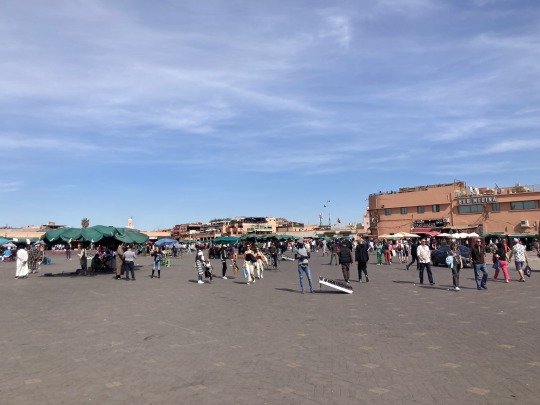#jemaa el-fna
Text
Weg ins Paradies

Der 'Platz'
Marrakesch - verwirrend, exotisch, authentisch
„Die Stadt wird dich verführen!“, sagte ein Freund. Er sollte Recht behalten. Sie umfängt mich mit all ihren Reizen. Sinnlich und lasziv, duftend nach Safran, Jasmin, Rosenwasser und Minze, stinkend nach Kloake und Pisse. Im Stadtteil Gueliz gibt sie sich fashionable, drüben, in der Medina, als wäre sie im Mittelalter versunken. Marrakesch ist betörend schön und abstoßend hässlich, immer aber voll von Leben. Und Farben. Und Liebe. Verwirrend. Exotisch. Authentisch.

Am Jemaa el Fna Platz
Jede Herrscherdynastie schmückte sich mit einer anderen Blüte. Bei den Almoraviden, Almohaden und Saadiern war Marrakesch erste Stadt des Landes, die Alawiden setzten auf Meknès, die Idrisiden und Meriniden wieder erkoren Fès zur Hauptstadt. Heute regiert Mohammed VI. von Rabat aus über sein Land, trotzdem sich längst eine andere Stadt zur größten des Königreiches entwickelte: Casablanca. Immer noch also rittern die Königsstädte um die Gunst der Stunde - und um die der Touristen. Die „Rote Stadt“ Marrakesch aber trägt zweifellos den Sieg davon. Keine andere Stadt verbirgt ähnlich viel Liebreiz unter ihrer Takschita, wie sie. Lass dich betören, Fremder! Irre durch die schmalen Gassen der Medina, spaziere durch die prachtvollen Gärten, erobere das Labyrinth der Souks, entdecke Paläste und Hinterhöfe, folge herrlichen Gerüchen, und probiere all die geheimnisvollen Speisen aus den Kochbüchern von tausendundeiner Nacht. Marrakesch ist die Göttin des Maghreb.

Pferderennen vor der Koutoubia Moschee
Etwa zweihundert Kilometer von der Küste entfernt, liegt sie auf halben Weg zum Hohen Atlas, dem mächtigen Gebirgszug im Süden ihrer Stadttore. Während tagsüber die Hitze Afrikas den Menschen den Atem raubt, sind die Nächte kühl und trocken. Die aber verbringt man am besten in einem der gut verborgenen Privathäuser, genießt ihren orientalischen Luxus und lässt sich im Innenhof mit einem „Thé à la menthe“ verwöhnen.
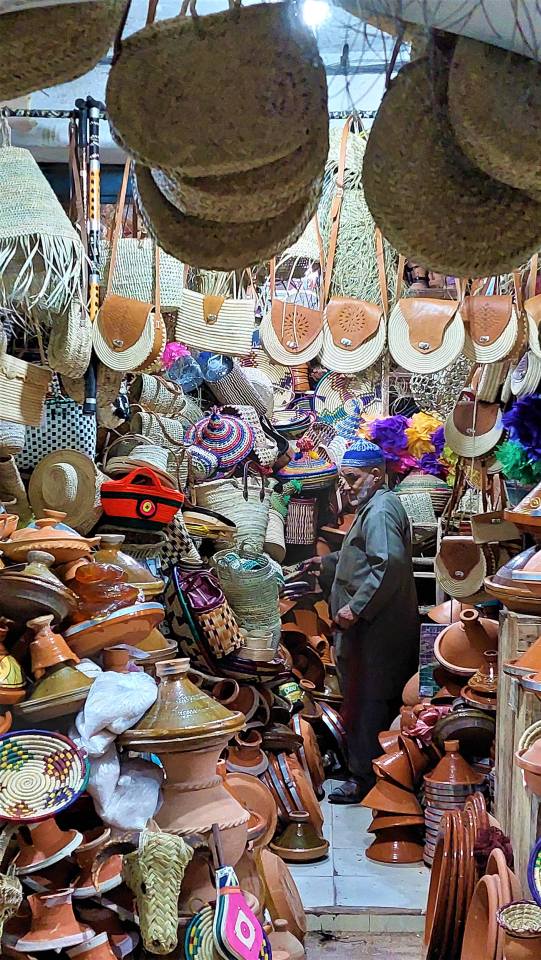
Im Souk
Marrakesch ist in jeder Beziehung eine Reise wert. Rituale und Hightech, Moderne und Tradition. All das findet der Reisende, kaum dass er den tiefgekühlten Airport Menara hinter sich lässt und eine Welt betritt, die aus Märchen, Mythen und jeder Menge Minzblätter besteht.
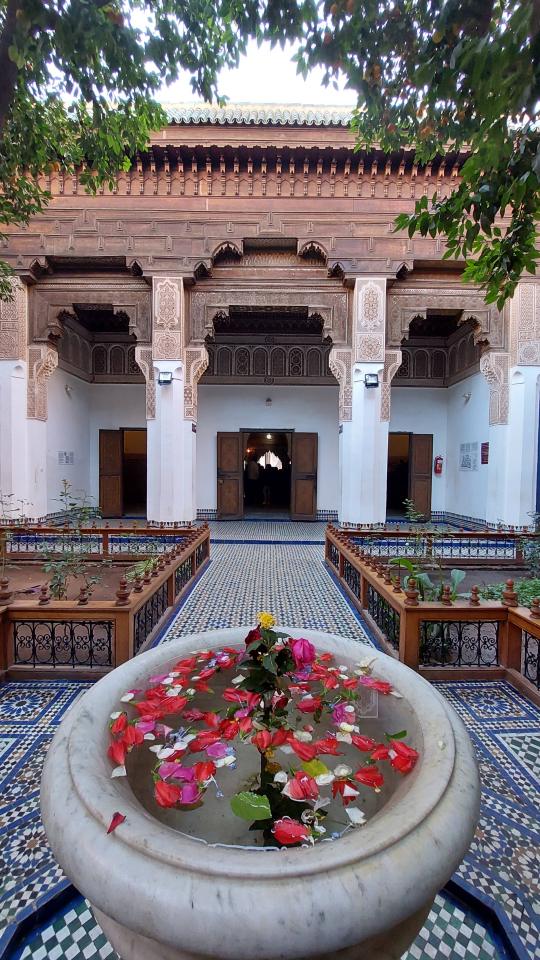
Bahia Palast
Moscheen und Paläste
Palais de la Bahia – „Die Strahlende“, wie der Palast genannt wird, ist eine grandiose Flucht von Sälen und Höfen. Eine exotische Welt, die allen Luxus orientalischer Herrscher bereithält
Koutoubia Moschee – Weithin schallt der Ruf des Muezzins, der vom hohen Minarett die Gläubigen zum Gebet ruft. A propos: Nicht-Muslimen ist der Eintritt in das, im maurischen Stil errichtete Wahrzeichen Marrakeschs verboten. Dennoch: Ansehen und bewundern – nur halt von außen
Palais El Badi – Die einst größte und prächtigste Palastanlage des Maghreb liegt inmitten einer Parkanlage und ist von einer stattlichen Mauer umgeben. Steinerne Zeugen längst vergangener Pracht
Medersa Ben Youssef – Das schönste Gebäude der Stadt. Die Koranschule umschließt einen beeindruckenden Innenhof, von dem aus sich ein Labyrinth aus unzähligen Räumen verzweigt
Koubba Ba’adiyn – Gegenüber der Ben-Youssouf-Moschee liegt ein Kleinod der besonderen Art: Die Koubba („Kuppel“) eines Pavillons, der sich Jahrhunderte lang unter der roten Erde verbarg
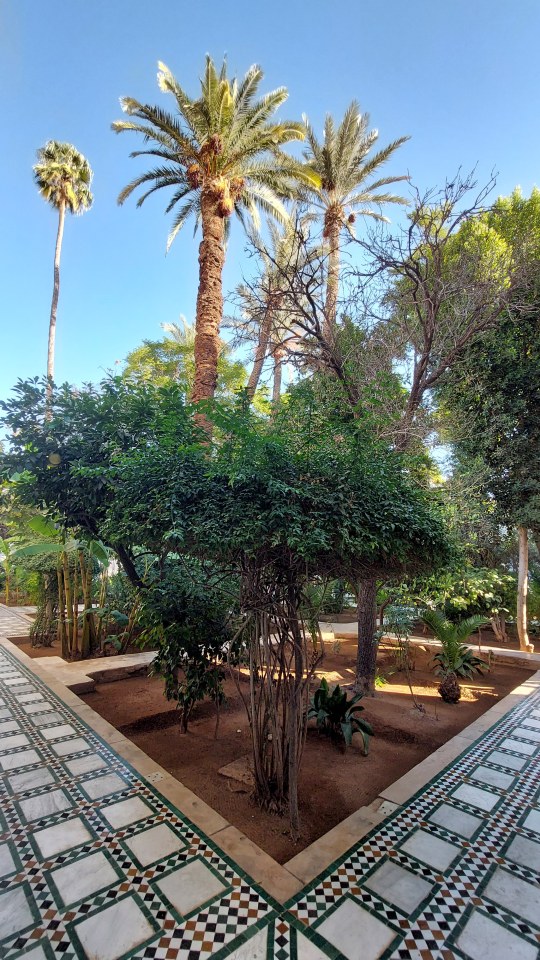
Garten im Bahia Palast, Marrakesch
Zu Gast im Riad
In einem der verzaubernsten Länder der Welt, lassen Connaisseure die Touristenhotels links liegen, und begeben sich auf die Suche nach dem „Paradies“. So und nicht anders lautet die wörtliche Übersetzung des Begriffes „Riad“. Gemeint ist eines jener unzähligen Stadtpalais, die sich hinter unscheinbaren Mauern verbergen, sodass es schon eine gehörige Portion Mut braucht, sich von einem der ortskundigen Guides durch das Labyrinth der schmalen Gassen führen zu lassen, um endlich vor einem, mit Eisennägeln verzierten Tor anzuhalten. Weder Hausnummer noch Türschild ist daran befestigt, weshalb auch, hier wohnen Einheimische, zu denen der Reisende ja schließlich gehören mag. Der Guide schlägt mit einem Klopfer gegen das Portal, worauf sich dieses wie von Zauberhand öffnet. Das Gezirpe aufgescheuchter Vögel, die in der Blütenpracht einer riesigen Bougainvillea Wache halten, der zarte Duft frisch geschnittener Rosen, das Plätschern des Springbrunnens in der Mitte des aus abertausenden Mosaiksteinen belegten Innenhofes, ein Kännchen mit heißem Pfefferminztee - all das beruhigt und beglückt den Neuankömmling und lässt den abenteuerlichen Anmarschweg vergessen. Man wird willkommen geheißen, nimmt Platz, genießt den Geruch von Orangenblüten und Patschuli, so wie den kühlenden Schatten, der vor den Sonnenstrahlen des heißen Tages schützt.
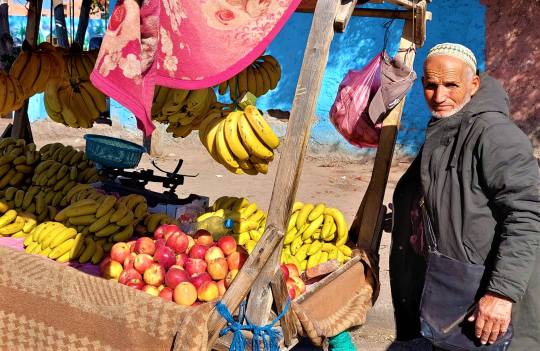
Am Markt El Gza
Viele Häuser wurden zusammengelegt und zu einem kleinen Stadtpalast umgestaltet. Hier, in dem von dicken Mauern umschlossenen Eiland, bleibt man nicht lange Gast – man fühlt sich bald schon wie zu Hause. Das Zimmer, das man bewohnen darf, geht auf den Innenhof, die übrige Welt bleibt außen vor. In den kühlen Räumen, die als Ess- und Frühstücksbereich genutzt werden, lebt die Vergangenheit des Landes. Holzdecken, Fresken, Kachelornamente verzieren die Säle, Pölster und Decken beschützen orientalische Möbeln, auf den Marmorböden liegen Berberteppiche, und im Kamin knistern an kühlen Abenden Holzscheite. Der Europäer staunt, der alternativ Reisende ist entzückt. Das Serail eines Sultans könnte nicht beeindruckender sein.

Medina
In einem Riad gibt es keinen Schlüssel, wozu auch, wo man sich wohl fühlt, verriegelt man keine Türe. Die Eingangspforte wird zu jeder Tages- und Nachtzeit von einem guten Geist des Hauses bewacht. Und da die Türen und Fenster der Fremdenzimmer allesamt in den Innenhof führen, bekommt man bald auch vom Leben der Mitbewohner erzählt. Doch keine Angst vor allzu großer Nähe – die Anonymität eines Touristenhotels ist bei weitem bedrückender als die offene Atmosphäre eines Privathauses.
Der Tag in einem Riad beginnt mit einem üppigen Frühstück, und schließt, so man mag, mit einem luxuriösen Dinner. Der Tisch ist dann mit Blumen geschmückt, die Gläser funkeln im Kerzenschein der Kandelaber, das Tafelsilber glänzt und auf dem Porzellan der Teller befindet sich nicht selten das Familienwappen des Patrons. Das Wohnen wird zelebriert wie nirgendwo sonst, und der Gast, der ist hier Kalif. Und das bitte, das ist nicht nichts!
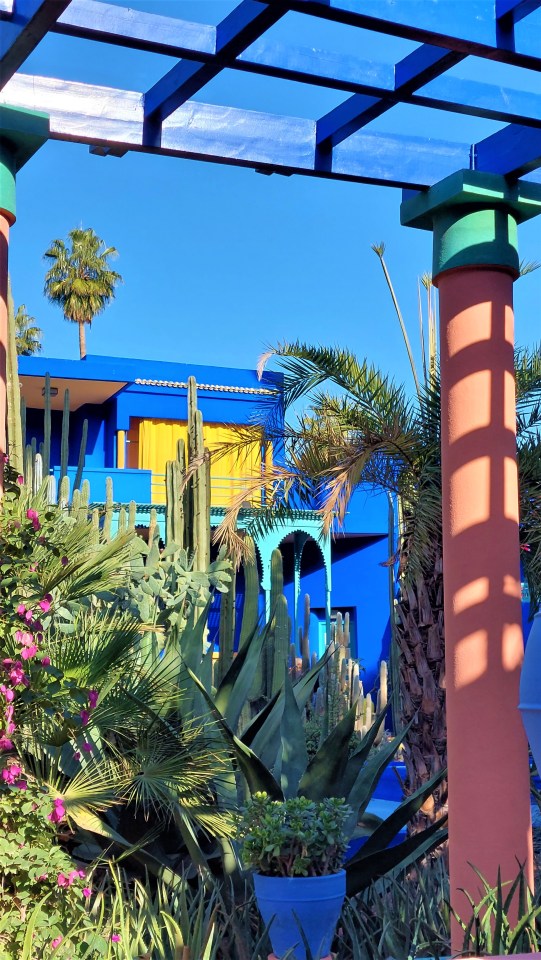
Jardin Marjorelle
Was auf den Tisch kommt
Pastilla – Traditionelles Festessen. Der Teig wird mit Fleisch, Huhn oder Tauben gefüllt, dazu reichlich Gemüse
Harira – Passierte Gemüsesuppe, darin Bohnen, Linsen, Kichererbsen, nebst allen Gewürzen des Orients
Tajine – In einem tönernen, zylindrischen Gefäß schmurgelt Fleisch und Gemüse so lange, bis es zu einem göttlich-saftigen Eintopf gegart ist
Tanjia – ähnlich wie oben, nur dass das Schmorgut in eine Amphore gefüllt wird, die an ihrer Oberseite verschlossen ist
Fladenbrot
Danach - Jede Menge Süßigkeiten und frisches Obst
Zum Trinken - Thé à la menthe, Tafelwasser


Im Jardin Marjorelle & Museum Yves St. Laurent
Vergils Weg
Ein Spaziergang durch die Stadt gleicht einer Reise auf den Spuren des Dichters Vergil durch Dantes „Göttliche Komödie“. Wo sonst durchmisst man „Inferno“, „Purgatorio“ und „Paradiso“ in so kurzer Zeit wie hier. Der Platz „Jamaa el Fna“, die Attraktion des touristischen Marrakeschs, liegt im Zentrum der Altstadt und fungierte in früheren Zeiten als Richtstätte. Am „Platz der Zerstörung“ wurde geköpft und gehenkt was das Zeug hielt. Wo, wenn nicht in einem Land, in dem Religion und Staat eine Allianz bildet, liegt Tat und Strafe nahe beisammen, und das sensationslüsterne Volk sieht dabei zu. Abschrecken heißt Vorbeugen. Den Richtern war’s recht, und die Henker wallten ihres Amtes. Kaufleute, Zahnbrecher, Gaukler, Schlangenbeschwörer und Garküchenbetreiber tummelten sich auf dem riesigen Platz und machten zur Richtstunde ihr Geschäft. Die Symbiose zwischen Tod und Leben war im Halsumdrehen geschaffen, und sie hält bis heute an. Zwar kamen in neuerer Zeit ein paar Fruchtsaftbuden und Folkloretänzer hinzu, das Gesetz des Überlebens aber ist unverändert. Wer der Touristenhölle mit Leib, Leben und gesundem Geldbeutel entkommt, hat es geschafft, ins Fegefeuer – verlangt doch der Weg zur Erlösung dem Wanderer noch eine weitere Prüfung ab.

Affenshow am Jemaa el Fna
In Marrakesch entspricht die labyrinthische Medina, vulgo „Souk“, dem Überwinden Dantes „Purgatorio“. Die mittelalterliche Shopping-Mall hat es in sich. Gnadenlos wird der Fremde dem Zauber orientalischer Verführungskunst ausgesetzt. Das Halali ist eröffnet, denn kaum setzt der Büßer seinen Fuß in die vom Tageslicht fahl beleuchteten Gänge, überfällt ihn eine, alle Sinne betäubende Flut an Gefahren und Gerüchen: Abgaswolken von Mopeds, verdauende Esel, umstürzende Gemüsekarren, Botenläufer, die sich ihren Weg freispucken, Essensgerüche, Parfümschwaden, und der beißende Geruch von Garküchen: Das Fegefeuer hält für jeden etwas bereit, und seien es auch nur Helping Hands, die flink nach Rucksäcken greifen. Daneben Waren aller Art: Fleisch, Teppiche, Silberwaren, Gewürze, Lederpantoffel, Krimskrams und Kokolores. Wer will noch mal, wer hat noch nicht. Verängstigt taumelt der Hilfesuchende durch das Chaos, indes sich Trauben von Ortskundigen mit ihm verbrüdern, um gegen kleines Geld den Weg zu weisen. Und längstens dann entgeht man alttestamentarischer Strafe nicht, denn das „Quartier des Tanneurs“, das Gerber-Viertel ist erreicht. Der Gestank, der einen hier erwartet und in dem die Ärmsten der Armen ihrer erbärmlichen Arbeit nachgehen, bleibt unvergesslich. Hier heißt es: Nase zu und durch! Vorbei am „Musée du Parfum“ oder dem „Maison de la Photographie“, stolpert man endlich einem der mächtigen Medina-Tore zu, und, wenn man Glück hat, eröffnet sich einem dort das goldene Licht des zu Ende gehenden Tages.
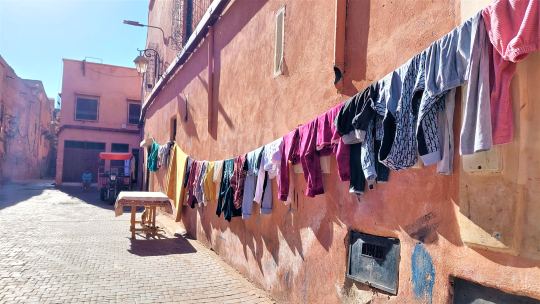
Im jüdischen Viertel von Marrakesch
„Gueliz“ heißt das schicke Viertel der alten Königsstadt. Palmen-Alleen, blühende Jacaranda-Bäume, Villen inmitten prachtvoller Gärten, übersät mit Bougainvilleas. Hier wohnt, wer es sich leisten kann. Mit der mittelalterlichen Innenstadt hat dieser Stadtteil nichts zu tun. Ein französischer Modeschöpfer hat hier vor Jahren nach der Sehnsucht Ausschau gehalten – und sie gefunden. Der „Jardin Majorelle“ ist eine Offenbarung aus Natur und Poesie, ein Garten der Inspiration, angelegt vom Malerfürsten Jacques Majorelle, Jahre später verfeinert vom Genius Yves Saint Laurent mit Sinn für das Schöne und Teure. Hier fühlt sich der nach Erlösung Suchende am Ziel: Bambushaine, Agaven, Wasserbecken, exotische Hölzer, Blumen und Kakteen – und eine „Villa“, die die Pracht Arkadiens in den Schatten stellt. Das Abendrot Marokkos lässt die Farben des Modeschöpfers noch leuchtender erstrahlen, als sie es ohnehin schon sind: Blau, Orange, Mauve, Gelb. Nirgendwo möchte man länger verweilen als eben hier. Der Weg Vergils ist beschritten, das „Paradiso“ erreicht.
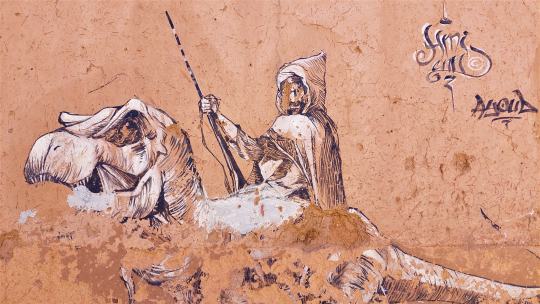
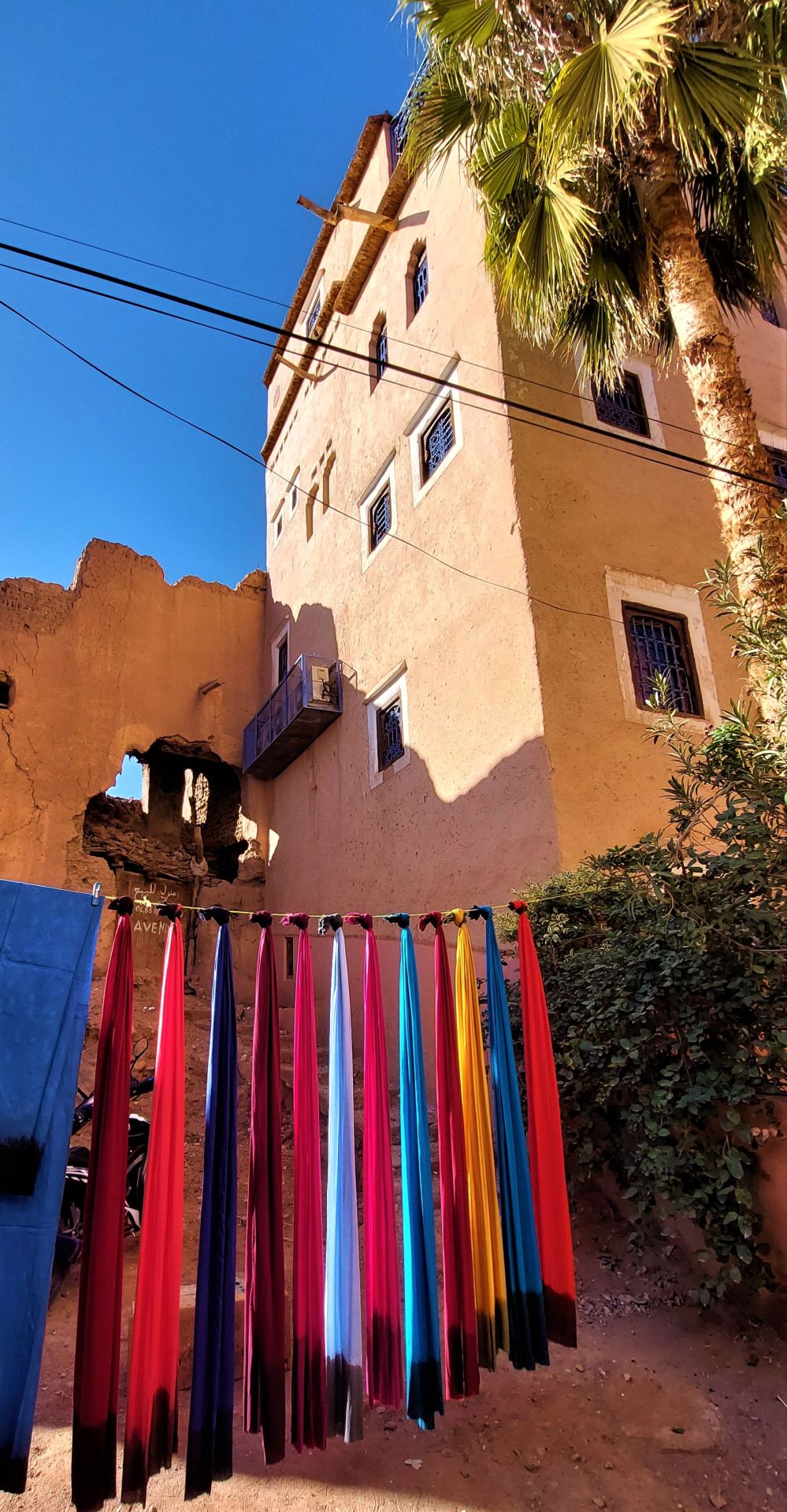
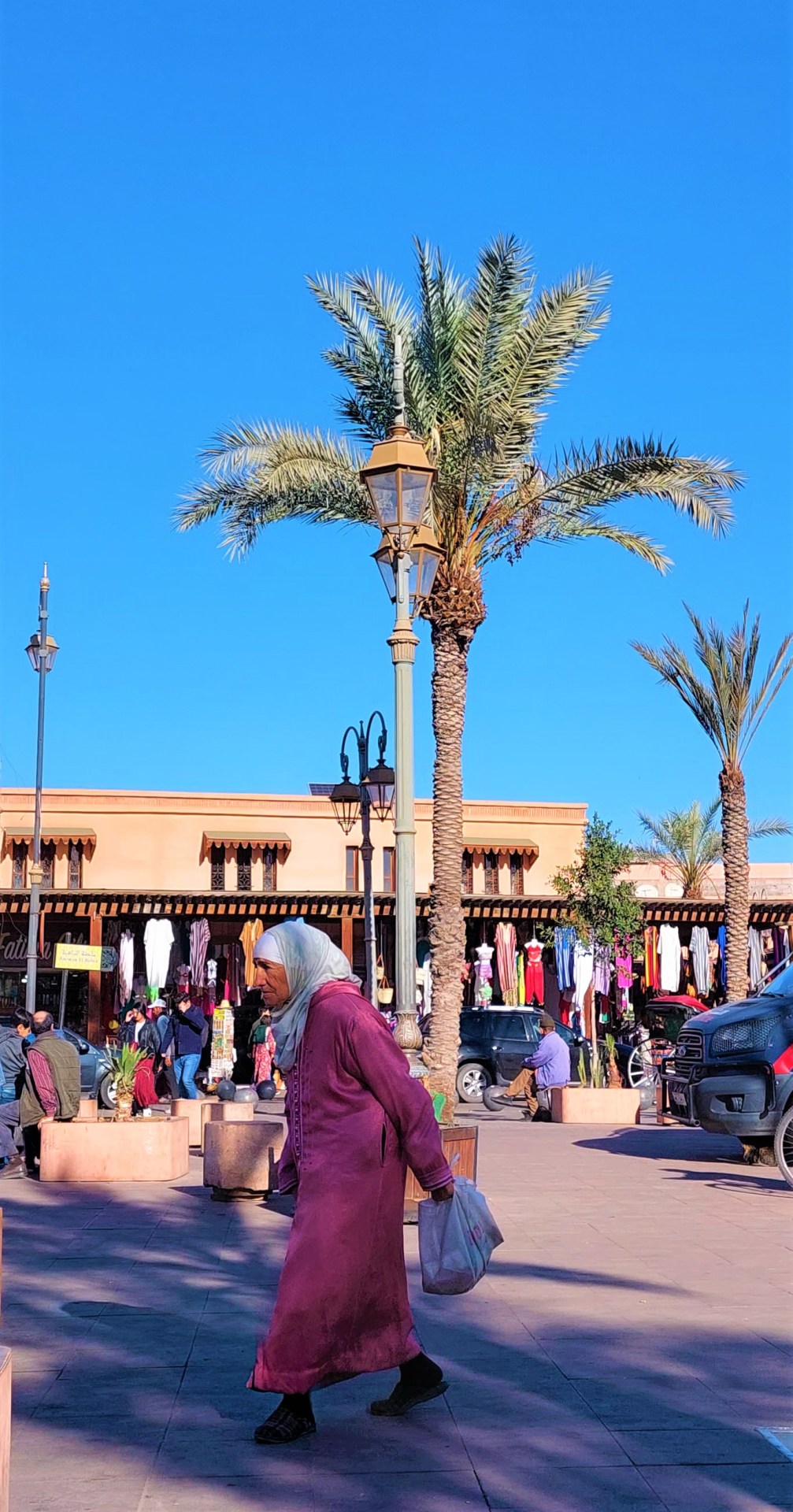
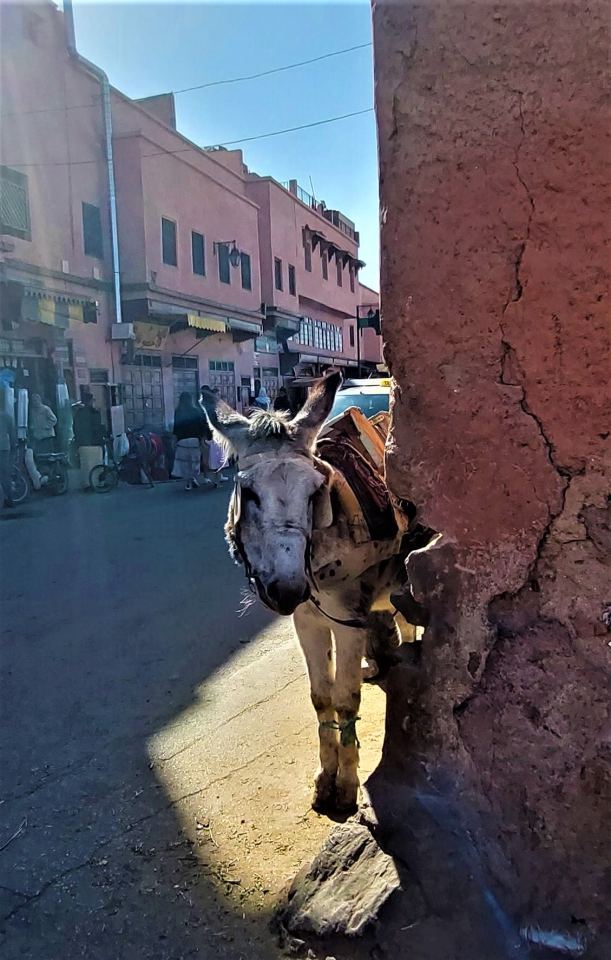



#michael schottenberg#schotti#schotti unterwegs#schotti to go#orf#Studio 2#Marrakesch#Marokko#Jemaa el Fna#Bahia Palast
3 notes
·
View notes
Text
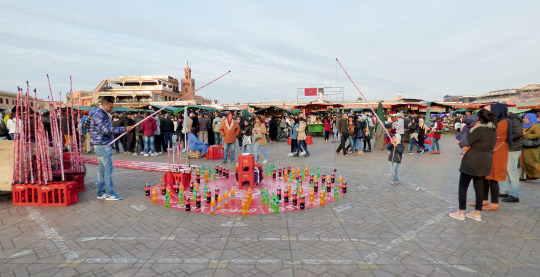
Today's Flickr photo with the most hits: Go Fish, Jemaa el Fna, Marrakech.
0 notes
Text
MARRAKECH, LA CODICIADA MEDINA IMPERIAL; Por Rosana Saburo
El legado e historia de Marrakech se unen al ritmo de una ciudad turística, bulliciosa, vital, exótica, que se resiste a perder una posición cultural, privilegiada en el tiempo.
Ubicada estratégicamente, lugar de paso, además de sus ventajas militares y defensivas, pronto la actividad comercial avanzó en su día a día; Que fuera tan deseada por muchos, le hizo pasar por etapas de imposiciones y…

View On WordPress
1 note
·
View note
Text


By Sam Metz
September 11, 2023
An earthquake has sown destruction and devastation in Morocco, where death and injury counts continue to rise as rescue crews dig out people both alive and dead in villages that were reduced to rubble.
Law enforcement and aid workers — both Moroccan and international — have arrived in the region south of the city of Marrakech that was hardest hit by the magnitude-6.8 tremor on Friday night and several aftershocks.
Residents await food, water and electricity, and giant boulders now block steep mountain roads.
Here’s what you need to know:
WHAT ARE THE AREAS MOST AFFECTED?
The epicenter was high in the Atlas Mountains about 70 kilometers (44 miles) south of Marrakech in Al Haouz province.
The region is largely rural, made up of red-rock mountains, picturesque gorges and glistening streams and lakes.
For residents like Hamid Idsalah, a 72-year-old mountain guide from the Ouargane Valley, it is unclear what the future holds.
Idsalah relies on Moroccan and foreign tourists who visit the region due to its proximity to both Marrakech and Toubkal, North Africa’s tallest peak and a destination for hikers and climbers.
“I can’t reconstruct my home. I don’t know what I’ll do. Still, I’m alive so I’ll wait,” he said as rescue teams traversed the unpaved road through the valley for the first time this weekend.
The earthquake shook most of Morocco and caused injury and death in other provinces, including Marrakech, Taroudant and Chichaoua.
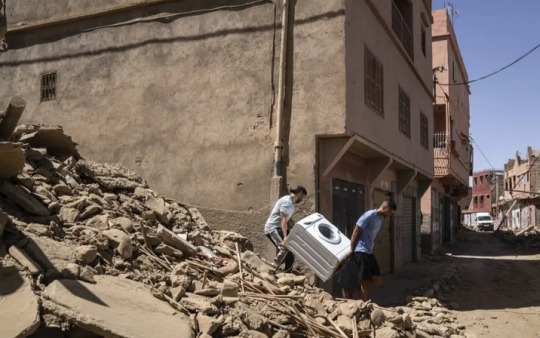
WHO WAS AFFECTED?
Of the 2,122 deaths reported as of Sunday evening, 1,351 were in Al Haouz, a region with a population of around 570,000, according to Morocco’s 2014 census.
People speak a combination of Arabic and Tachelhit, Morroco’s most common Indigenous language.
Villages of clay and mud brick built into mountainsides have been destroyed.
Though tourism contributes to the economy, the province is largely agrarian.
And like much of North Africa, before the earthquake, Al Haouz was reckoning with record drought that dried rivers and lakes, imperiling the largely agricultural economy and way of life.
Outside a destroyed mosque in the town of Amizmiz, Abdelkadir Smana said the disaster would compound existing struggles in the area, which had reckoned with the coronavirus pandemic in addition to the drought.
“Before and now, it’s the same,” said the 85-year-old. “There wasn’t work or much at all.”
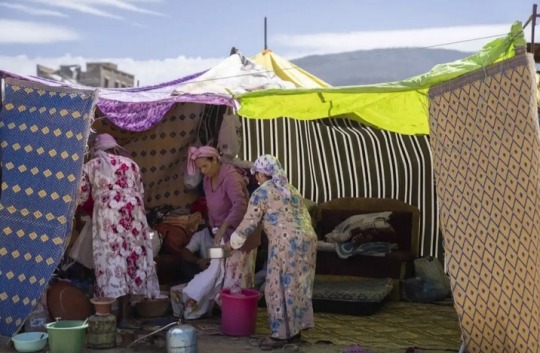
WHO IS PROVIDING AID?
Morocco has deployed ambulances, rescue crews and soldiers to the region to help assist with emergency response efforts.
Aid groups said the government has not made a broad appeal for help and accepted only limited foreign assistance.
The Interior Ministry said it was accepting search and rescue-focused international aid from Spain, Qatar, Britain and the United Arab Emirates, bypassing offers from French President Emmanuel Macron and U.S. President Joe Biden.
“We stand ready to provide any necessary assistance for the Moroccan people,” Biden said Sunday on a trip to Vietnam.
WHY IS MARRAKECH HISTORIC?
The earthquake cracked and crumbled parts of the walls that surround Marrakech’s old city, a UNESCO World Heritage site built in the 12th century.
Videos showed dust emanating from parts of the Koutoubia Mosque, one of the city’s best known historic sites.
The city is Morocco’s most widely visited destination, known for its palaces, spice markets, tanneries and Jemaa El Fna, its noisy square full of food vendors and musicians.

HOW DOES THIS COMPARE TO OTHER QUAKES?
Friday’s earthquake was Morocco’s strongest in over a century but, though such powerful tremors are rare, it isn’t the country’s deadliest.
Just over 60 years ago, the country was rocked by a magnitude-5.8 quake that killed over 12,000 people on its western coast, where the city of Agadir, southwest of Marrakech, crumbled.
That quake prompted changes in construction rules in Morocco, but many buildings, especially rural homes, are not built to withstand such tremors.
There had not been any earthquakes stronger than magnitude 6.0 within 310 miles (500 kilometers) of Friday’s tremor in at least a century, according to the U.S. Geological Survey.
Northern Morocco experiences earthquakes more often, including tremors of magnitude 6.4 in 2004 and magnitude 6.3 in 2016.
Elsewhere this year, a magnitude 7.8 temblor that shook Syria and Turkey killed more than 21,600 people.
The most devastating earthquakes in recent history have been above magnitude 7.0, including a 2015 tremor in Nepal that killed over 8,800 people and a 2008 quake that killed 87,500 in China.
WHAT ARE THE NEXT STEPS?
Emergency response efforts are likely to continue as teams traverse mountain roads to reach villages hit hardest by the earthquake.
Many communities lack food, water, electricity, and shelter.
But once aid crews and soldiers leave, the challenges facing hundreds of thousands who call the area home will likely remain.
Members of the Moroccan Parliament are scheduled to convene Monday to create a government fund for earthquake response at the request of King Mohammed VI.
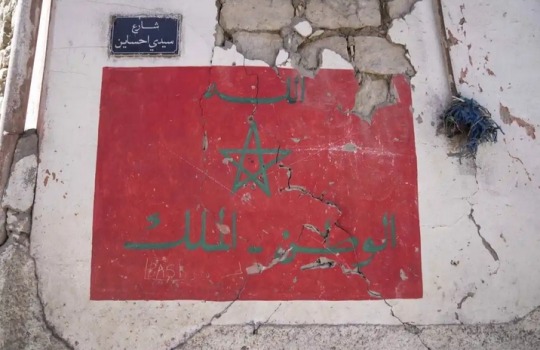
#Morocco#Morocco Earthquake#earthquake#Marrakech#Al Haouz province#Atlas Mountains#Taroudant#Chichaoua#Interior Ministry#Koutoubia Mosque#Moroccan Parliament#King Mohammed VI
92 notes
·
View notes
Text
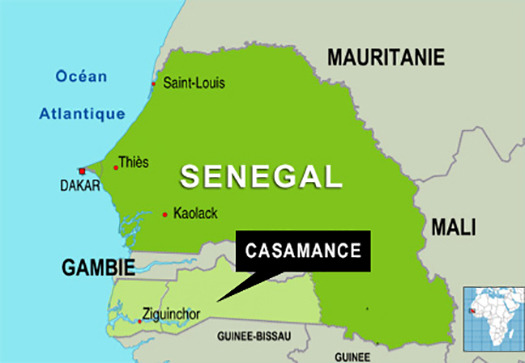

SAMEDI 13 JANVIER 2024 (Billet 2 / 3)
Comme promis nous vous racontons l’histoire des photos que nous avons choisies pour notre Carte de Vœux 2024. Elles ont toujours une histoire nos Cartes de Voeux, souvenez-vous de celle de l’année dernière, illustrée par une belle aquarelle de la Place Jemaa el Fna et une calligraphie en arabe et en français, le tout réalisé par un ami marocain, Rachid, un ancien GO, retrouvé par le plus grand des hasards dans la Médina de Marrakech. Mais les hasards existent-ils ?...
Jeudi 28 décembre 2023 nous avions rendez-vous à 16 heures avec Justin à l’entrée du Village. Nous avions connu Justin en 2014 lorsque nous sommes allés pour la première fois au Club Med de Cap Skirring. Cette année-là nous avons fait pratiquement toutes les sorties au programme du service des Excursions, mais pas uniquement avec le Club.
Sur la plage, entre les rangées de transats et les parasols réservés aux GM (rappel : les GM ce sont les clients du Club) et l’océan, tous les jours, défilent des Sénégalais qui vendent des paréos, de l’artisanat local… et certains proposent diverses excursions, souvent analogues à celles du Club mais à des tarifs beaucoup plus intéressants. Dans le cas de Justin, ce fut un peu particulier car nous avons fait partie de ses tout premiers « clients ». Nous nous souvenons lui avoir même donné des conseils de « marketing », un bien grand mot mais qui consistaient essentiellement à lui dire d’avoir par exemple dans son sac à dos un book, avec des photos pour « montrer » ses excursions, des horaires et des tarifs précis…
Revenus en 2018 puis en 2019, nous lui sommes restés fidèles et avons même gardé le contact le reste de l’année grâce à WhatsApp. Nous avons eu comme ça l’occasion de le recommander à plusieurs reprises à des GM qui ont été toujours très satisfaits de ses services. Parmi les derniers, Corinne et Dominique (devenus des amis et des lecteurs/abonnés du Blog depuis), qui sont venus à Cap Skirring l’année dernière. Ils l’ont beaucoup sollicité et gardent un excellent souvenir de ce qu’ils ont fait ensemble, dont de la bicyclette pour Dominique, grand amateur de la Petite Reine.
Ce (long ?) préambule pour que vous compreniez les liens qui peuvent se tisser entre les GM, le personnel (70% des GO et 100% des GE sont sénégalais), mais aussi la population locale. Le village de Cap Skirring (1823 âmes) s’est créé « autour » du Village du Club Med. Avant, il n’y avait quasiment rien, si ce n’est quelques paillotes de pêcheurs…
Mais revenons à Justin qui nous a proposé d’assister à un coucher de soleil dans les bolongs, les bolongs étant « des bras de mer, répertoriés comme de petits affluents à l’embouchure du fleuve Casamance » (merci Wikipédia pour la définition). Ils sont bordés de mangroves à palétuviers dont les racines sont souvent recouvertes de petites huitres. Ils servent aussi de refuges à toutes sortes d’oiseaux. [Pour info, voir les 2 cartes ci-dessus qui montrent la région du Sénégal appelée La Casamance, située entre la Gambie et la Guinée Bissau… et, tout en bas, pratiquement à la frontière entre La Casamance et la Guinée Bissau, le Village du Club Med de Cap Skirring.]
La balade se fait bien sûr en pirogue et comme entre la plage et la pirogue il peut y avoir un mètre ou deux de sable vaseux, Marina a été portée par le piroguier et JM par Justin.
Les photos qui suivent se passent de tout commentaire, à noter seulement que nous nous sommes arrêtés sur une petite île où nous avons fait la connaissance de quelques familles qui y vivent presque en autarcie. Justin les connaissant, nous avons pu avoir des échanges très sympathiques avec de jeunes mamans (tous les hommes devaient être partis à la pêche), entre autres au pied d’un baobab majestueux,nous offrant un somptueux contre-jour… le début d’un coucher de soleil, au fil de l’eau, en longeant les mangroves, dans un silence magique juste rompu de temps en temps par les cris d’un oiseau dans le lointain... Un moment totalement « out of the world ! ». Lorsque nous avons regagné la terre ferme, il était 19h45.
Le lendemain, après avoir visionné les photos, nous nous sommes dit que c’était cette excursion que nous voulions évoquer pour nos Vœux. Voilà pourquoi tous les mots qui nous sont venus en les rédigeant ne pouvaient qu’évoquer l’émerveillement, la sérénité, la paix et l’amour…

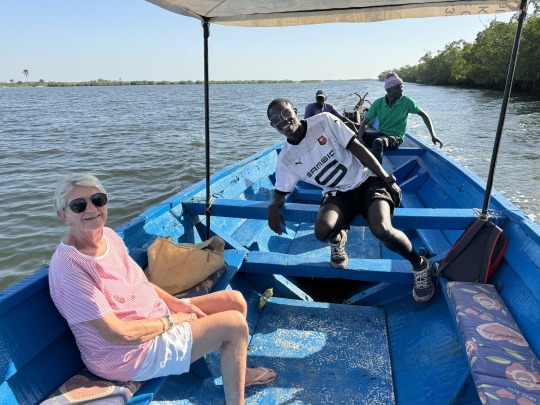

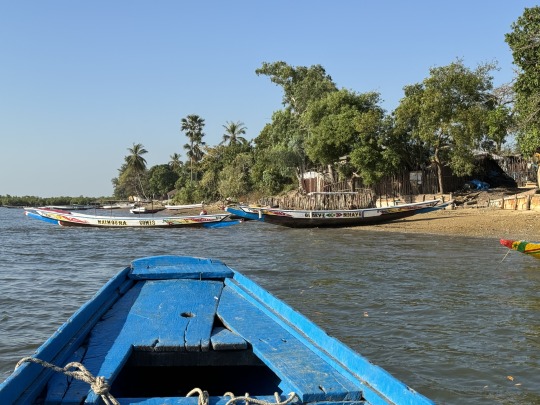
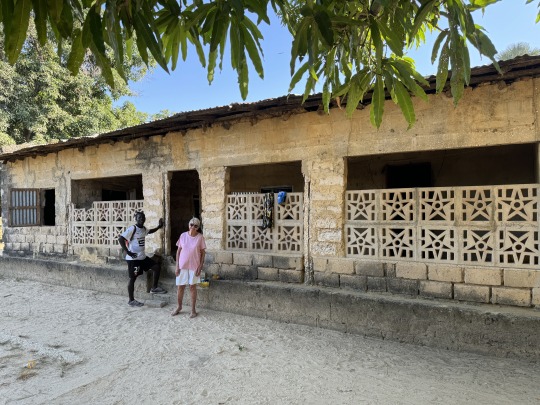

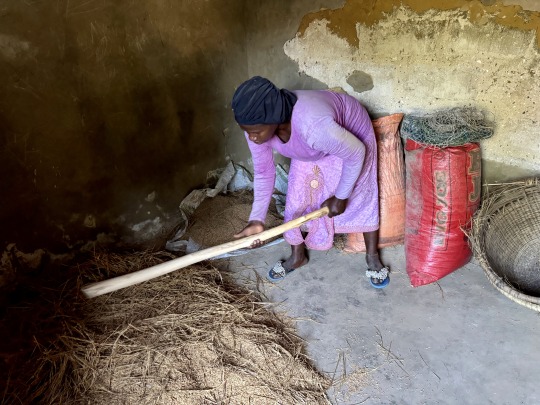
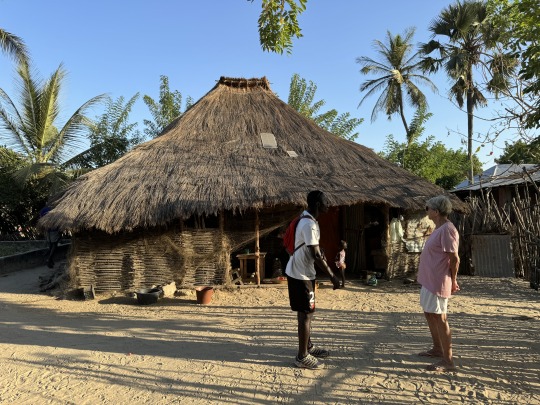

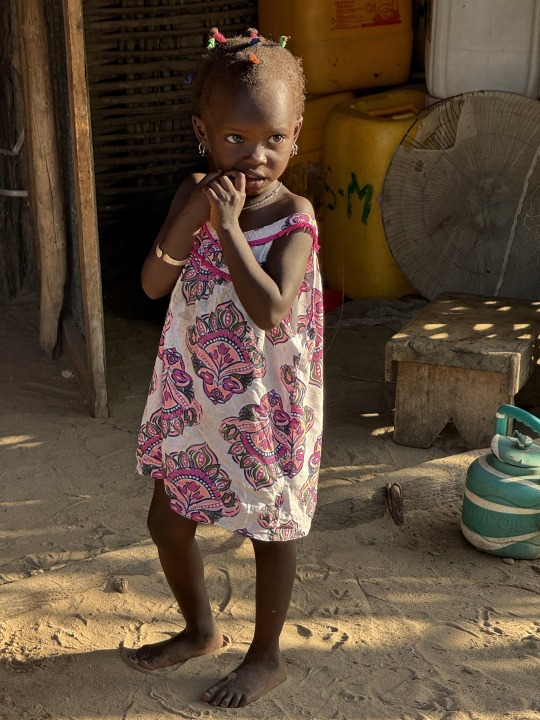


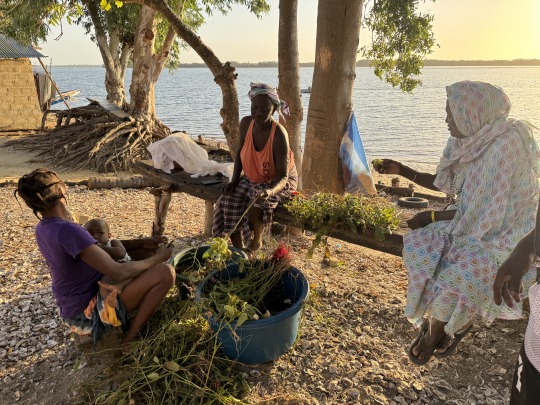







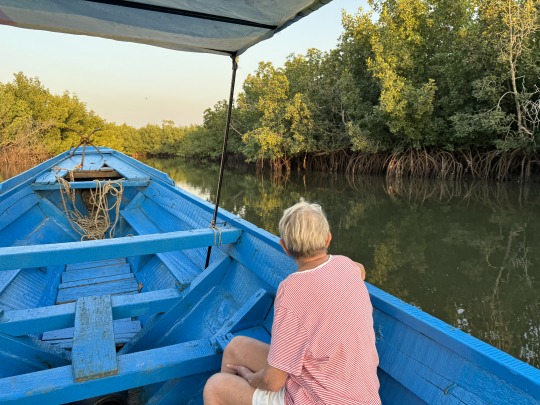

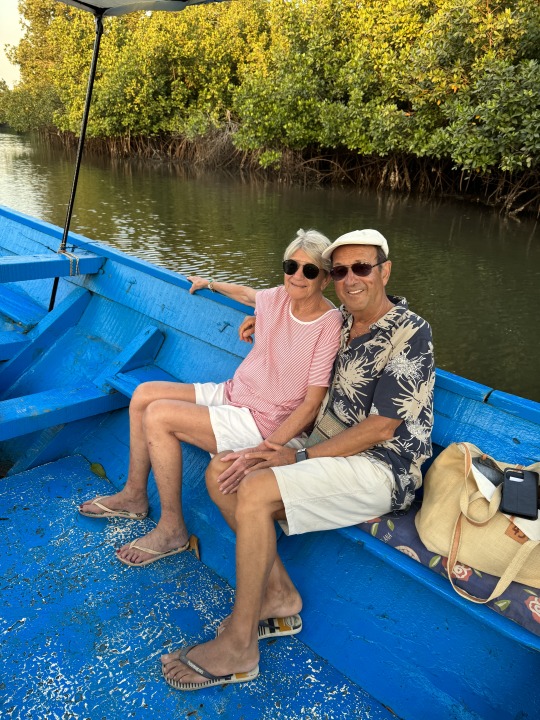


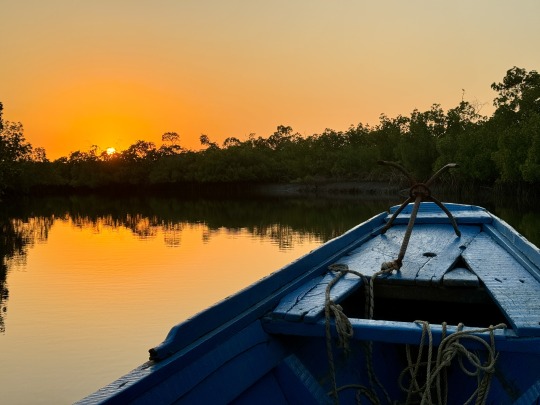
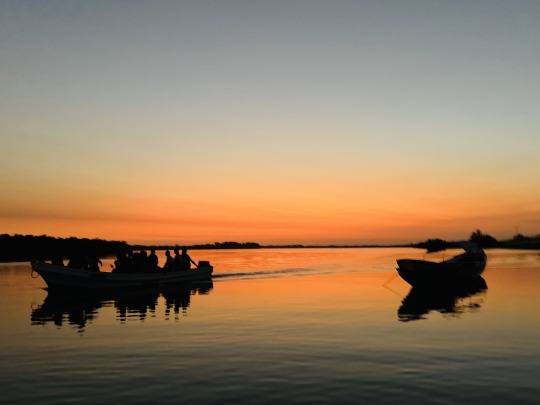

2 notes
·
View notes
Text

Jemaa El Fna, Marrakesh, Morocco Jean Besancenot, 1930s
2 notes
·
View notes
Text




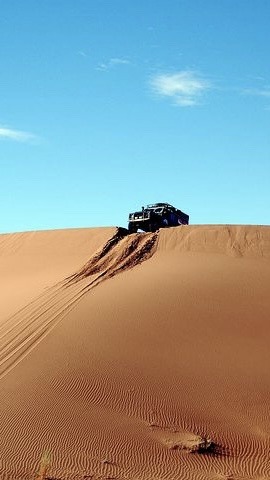
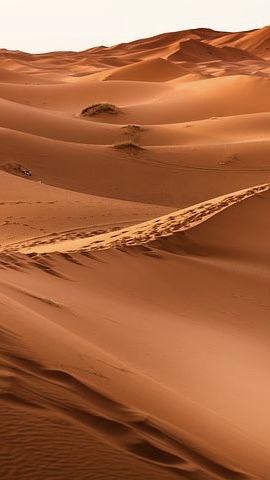
Le Maroc, pays d'Afrique du Nord sur le littoral de l'Atlantique et de la Méditerranée, se distingue par ses influences berbères, arabes et européennes. La médina de Marrakech, quartier médiéval aux allures de labyrinthe, est un lieu animé, avec sa place Jemaa el-Fna et ses souks (marchés) vendant des céramiques, des bijoux et des lanternes en métal. La casbah des Oudayas à Rabat, la capitale, est un fort royal du XIIe siècle qui surplombe l'océan.
11 notes
·
View notes
Text
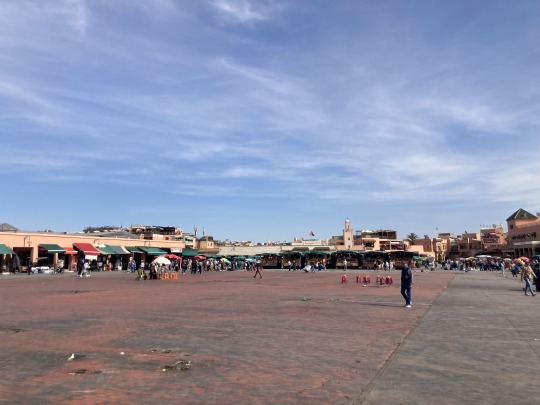
0 notes
Text
Jemaa El Fna in Marrakesh
Jemaa El Fna in Marrakesh
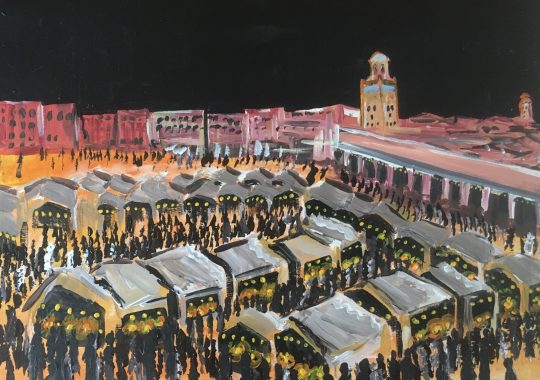
View On WordPress
3 notes
·
View notes
Text
Discovering the Culinary World: The Rise of Halal Food Tourism
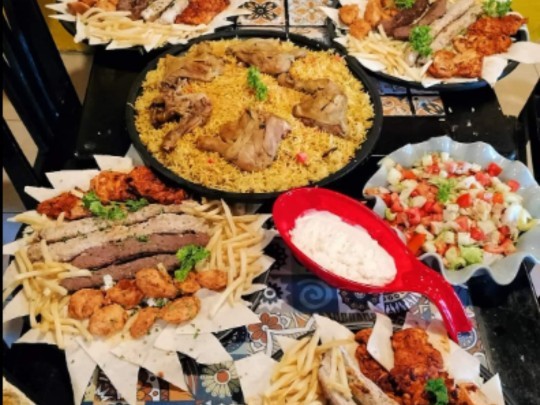
Are you ready for a journey that will tantalize your taste buds and broaden your culinary horizons? Well, get ready to embark on a flavorful adventure as we explore the exciting world of halal food tourism. From vibrant street markets to fine dining establishments, halal cuisine is taking the travel industry by storm, offering travelers a delicious way to experience new cultures and traditions. So, grab your passport and let's dive into the diverse destinations and culinary experiences that await!
Embracing Halal Cuisine: A Global Phenomenon
Halal food tourism is not just a trend – it's a global phenomenon that's on the rise. With the growing Muslim population and an increasing demand for halal-certified products, destinations around the world are catering to the needs of halal-conscious travelers. From bustling metropolises to serene seaside towns, there's no shortage of places to explore and dishes to savor.
The Appeal of Halal Food Tourism
What makes halal food tourism so appealing? Well, for starters, it offers travelers the opportunity to experience authentic flavors and culinary traditions from different cultures. Whether you're sampling street food in Malaysia or dining at a Michelin-starred restaurant in Dubai, halal cuisine provides a delicious window into the local way of life. Plus, with the rise of social media and food blogging, halal food tourism has become a hot topic among travelers seeking unique and Instagram-worthy dining experiences.
Top Destinations for Halal Foodies
So, where should you go to satisfy your halal food cravings? Here are some top destinations that should be on every halal foodie's radar:
1. Istanbul, Turkey: Where East Meets West
Istanbul is a culinary melting pot where East meets West, resulting in a vibrant and diverse food scene. From sizzling kebabs to mouthwatering mezes, the city offers a treasure trove of halal delights waiting to be discovered. Be sure to visit the historic Spice Bazaar for a sensory overload of spices, sweets, and Turkish delights.
2. Kuala Lumpur, Malaysia: Street Food Paradise
Kuala Lumpur is a haven for street food lovers, with bustling markets and hawker stalls serving up a dizzying array of halal dishes. Don't miss the chance to sample iconic Malaysian favorites like Nasi Lemak, Roti Canai, and Char Kway Teow. And be sure to explore the vibrant neighborhoods of Little India and Chinatown for a taste of multicultural Malaysia.
3. Marrakech, Morocco: A Feast for the Senses
Marrakech is a feast for the senses, with its bustling souks, aromatic spice markets, and colorful tagines. Dive into the local cuisine with dishes like Moroccan couscous, tagine, and pastilla, washed down with a refreshing glass of mint tea. And don't forget to explore the iconic Jemaa el-Fna square, where food stalls come alive with music, dancing, and the tantalizing aroma of grilled meats.
4. Dubai, UAE: Culinary Capital of the Middle East
Dubai is a playground for foodies, with its world-class restaurants, celebrity chefs, and innovative dining concepts. Indulge in lavish buffets, fine dining experiences, or street food adventures – the choice is yours. Be sure to sample Emirati specialties like Al Harees, Machboos, and Luqaimat for a taste of authentic Arabian cuisine.
Halal Food Experiences Worth Traveling For
Now that we've covered some top destinations, let's delve into the unique halal food experiences that make them worth traveling for:
1. Cooking Classes and Culinary Workshops
What better way to immerse yourself in the local cuisine than by taking a cooking class or culinary workshop? Learn to prepare traditional dishes from expert chefs, explore local markets for fresh ingredients, and discover the secrets behind authentic flavors and techniques. Whether you're rolling sushi in Tokyo or making tajine in Marrakech, cooking classes offer a hands-on way to experience the joys of halal cuisine.
2. Food Tours and Tastings
Embark on a guided food tour or tasting journey to uncover hidden gems and culinary hotspots in your destination. Sample street food favorites, visit local markets and eateries, and learn about the history and cultural significance of each dish. From food walks in Istanbul to spice tours in Zanzibar, food tours offer a delicious way to explore the flavors of a new city while meeting fellow food lovers along the way.
3. Farm-to-Table Experiences
For a truly immersive dining experience, consider a farm-to-table excursion where you can harvest fresh ingredients and enjoy a meal prepared by local farmers and chefs. Whether it's picking olives in Tuscany or harvesting dates in Abu Dhabi, farm-to-table experiences allow you to connect with the land, the people, and the flavors of your destination in a meaningful way.
Conclusion: Savoring the Journey
In conclusion, halal food tourism offers travelers a unique opportunity to explore the world through the lens of food. Whether you're sampling street food in Kuala Lumpur or dining at a rooftop restaurant in Marrakech, halal cuisine allows you to experience the rich diversity of cultures and traditions that make our world so vibrant and delicious. So, why not pack your bags, follow your taste buds, and embark on a culinary adventure that will leave you hungry for more? Bon appétit!
Marmar Basha - Tomas Saco Branch
32 Tomas Saco St, Cagayan de Oro, Misamis Oriental
09177177747
1 note
·
View note
Text
The top 7 spectacular things to do in Morocco
Morocco is a treasure in North Africa that welcomes visitors with a world of surprises. Imagine yourself wandering through historic medinas, hearing tales of the past filtered through centuries-old walls, or watching the sun set over the immense Sahara Desert. Imagine experiencing the calm serenity of Chef chaouen's azure metropolis or the excitement of trekking the snow-covered Atlas Mountains. The ease of a Morocco holiday package from Dubai provides an easy entry point for people who desire to take in this alluring scenery. These carefully chosen packages act as an introduction to the essence of Morocco, ensuring that guests feel the attraction of its varied landscapes and rich customs rather than merely seeing them. Thus, let the voyage begin with the promise of memories waiting to be weaved and stories ready to be told, as the charm of Moroccan experiences beckons.
Here are some of the spectacular things to do in Morocco.
1. Time Travel in the Medinas: Wandering through the Medinas: Going through the old parts of Marrakech and Fes is like going back in time. There is the world's oldest university in Fes, and the city has more than 9,000 alleys full of shops, artists, and food sellers. In Marrakech's lively Jemaa el-Fna square, you can see snake charmers, acrobats, and singers. Every part of these medinas is full of history, and there's a story just waiting to be found.
2. Majestic Views: Snow-Capped Peaks: Trekking aficionados find paradise in the Atlas Mountains, which span Morocco. Wander through historic Berber settlements, take in the sight of snow-capped peaks, or even try to climb Mount Toubkal, the highest mountain in North Africa. Offering a respite from the busy city below, this mountain range's tranquil and breathtaking views are unparalleled.
3.Golden Adventures: The Sahara's Dunes: The golden dunes of the Sahara, especially those near Merzouga, make for a dreamy setting for an amazing desert adventure. You can ride a camel, camp out under the stars, and watch the sun go down over the endless sands. A sunrise over the Sahara is an event that you will never forget.
4. A Dream Walk: The Blue City's Alleys: The blue-washed houses of Chefchaouen, which are in the Rif Mountains, are what make the city famous. It's like travelling through a dream as you walk through its alleyways. This peaceful and pretty town is not only nice to look at, but it also has original Moroccan crafts, cheeses, and other goods from the area. The calm environment is a nice change from the busy towns in Morocco.
5. Harbor Views: Blue Boats and Fresh Catches: Essaouira, which used to be called Mogador, is a beautiful coastal town that combines history, culture, and rest by the sea. You can walk around the medina, which is on the UNESCO list, watch traditional blue boats bob in the harbour, or eat some fresh fish. Kite and windsurfers like this town because it has strong winds along the coast.
6. Meknes: A Tapestry of Royal Heritage: The Bab Mansour Gate and the Mausoleum of Moulay Ismail are two beautiful historical places in Meknes, one of Morocco's four royal towns. And just a short drive away is Volubilis, which is on the UNESCO World Heritage List. With their rolling hills in the background, these Roman ruins show us Morocco's old history and the extent of the Roman Empire in North Africa.
7. Unwinding the Moroccan Way: The best way to unwind after a day of exploring is to spend some time in a traditional Moroccan bath. There are these steam baths all over the country. They are a way to clean your skin by exfoliating and removing dirt. A dip, a scrub with a special soap called "black soap," and a massage are usually part of the process. It is a relaxing and culturally immersive event that makes you feel better.
Morocco is a great example of the amazing things that can be found there. Every street in its old medinas, every wave in its vast desert, and every colour in its bright bazaars tells a story of a rich and varied culture and past. The magic of Morocco can't be denied, whether you're drawn to the calm blue walls of Chefchaouen or the grandeur of the Atlas Mountains. Morocco holiday packages from Dubai make the dream even more attainable for people who want to explore this beautiful world without any trouble. These deals make it easy for tourists to plan the perfect trip that lets them experience the best of Moroccan culture and beauty. Let Morocco's many wonders call you as you think about your next big journey. They are ready to amaze and excite you. This place makes trips more than just trips; it turns them into stories.
0 notes
Photo

Spices at Place Jemaa el Fna Things to do in Marrakech Morocco.
Embark on a journey of flavors at Place Jemaa el Fna in Marrakech, Morocco. Immerse yourself in the rich scents and colors of exotic spices.
0 notes
Photo

Spices at Place Jemaa el Fna Things to do in Marrakech Morocco.
Embark on a journey of flavors at Place Jemaa el Fna in Marrakech, Morocco. Immerse yourself in the rich scents and colors of exotic spices.
0 notes
Text



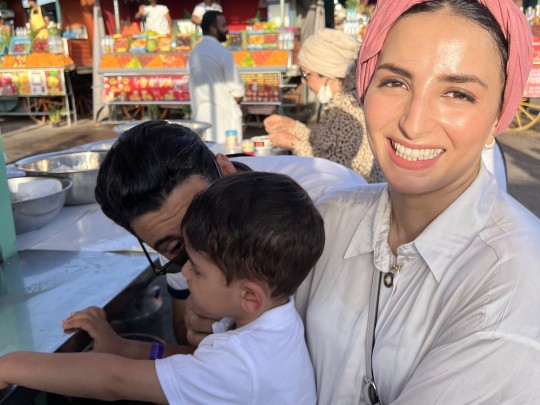
MERCREDI 13 JUILLET 2022 (Billet 2 / 5)
Le rendez-vous avait été donné à l’entrée de la Place Jemaa el Fna, juste à côté de l’ancien Village du Club Med, face aux célèbres (et très odorantes) calèches de la ville.
D’habitude JM fait des dizaines de photos lors de la traversée de cette place, tellement riches d’attractions diverses (charmeurs de serpents, orchestres Gnawa, montreurs de singes, conteurs d’histoires, acrobates, porteurs d’eau, etc.), mais ce jour-là, tout entier dans ses échanges avec ses amis et leurs enfants, son iPhone est resté dans sa poche.
Il était prévu de faire une halte « gourmande » et incontournable à l’autre bout de la Place, pour manger une spécialité marrakchie : de délicieux petits escargots cuisinés dans un bouillon assez poivré. Nous ne sommes d’ailleurs jamais venus sur cette Place sans nous arrêter dans l’un de ces petits stands (tous nos albums photo en attestent).
Ne manquez pas la petite vidéo ci-dessous. Certes, nous étions un vendredi et il y avait sur la Place un Festival de Musiques Traditionnelles… mais nous n’avions jamais vu autant de monde et entendu un tel bruit ! JM pensait qu’on n’allait rien saisir de son petit commentaire mais finalement, si vous dressez l’oreille, oui : une occasion de présenter tout le monde, les uns après les autres…
vimeo
3 notes
·
View notes
Link
[ad_1] Following the deaths of some 2,900 Moroccans from the recent earthquake that hit Marrakesh, the North African country long known for its breathtaking scenery and popularity with tourists is fighting back as it goes through a major rebuilding process.The powerful earthquake in the high Atlas Mountains that did such terrible damage to local villages and the historic town of Marrakesh was not the first major quake in Morocco. In 1960, a 5.8 magnitude quake leveled the resort city of Agadir, killing over 12,000 people and leaving 35,000 homeless. Jemaa el-Fna Square in Marrakesh, Morocco, August 2023. (Ilona Piasecki)A week after that disaster, King Mohammed of Morocco visited the site. He pledged that the town would be rebuilt by 1961.Morocco is a popular tourist destination, and Marrakesh was considered by many to be the Jewel of this North African nation. 6.8 MAGNITUDE EARTHQUAKE KILLS OVER 1,000 PEOPLE IN MOROCCO, RESCUE EFFORTS UNDERWAY El Badi Palace in Marrakesh, Morocco, August 2023. (Ilona Piasecki)It is also a former imperial city known for its many palaces, gardens and mosques. The Kutubiyya Mosque, the largest mosque in Marrakesh, Morocco, August 2023. (Ilona Piasecki)Approximately a seven-hour flight from New York, the country is located just across the Strait of Gibraltar and is easily accessible from Europe.Cruise ships and ferries sail from various European ports to Casablanca and Tangier. MOROCCO DEATH TOLL RISES TO 2,000 AFTER RARE, DESTRUCTIVE EARTHQUAKE STRIKES COUNTRY Rick's Café in Casablanca, Morocco, in 2018. (Danuta Hamlin)Casablanca, of course, needs no introduction. It was made famous in 1942 by an American film starring Ingrid Bergman and Humphrey Bogart as Rick Blaine, the owner of "Rick's Café Américain." Street Market in Casablanca, Morocco. (Danuta Hamlin)Tourists enjoy the hustle and bustle of Casablanca’s street markets and eateries. MOROCCO DEATH TOLL RISES AS SEARCH CONTINUES FOR SURVIVORS UNDER RUBBLE OF BUILDINGS THAT CRUMBLED The Hassan II Mosque in Casablanca, Morocco. (Danuta Hamlin)However, the most important site in Casablanca, for locals as well as visitors, is the grand Hassan II Mosque. It is the largest functioning mosque in Africa. It draws huge crowds, and it impresses both with its beauty and its size. Tangier, a Moroccan port on the Strait of Gibraltar. (Danuta Hamlin)The Port of Tangier, perched on the coasts of the Mediterranean Sea and the Atlantic Ocean is a unique city, bearing a multicultural heritage. Tangier, Medina district. (Danuta Hamlin)Tangier leads tourists back in time through the maze of narrow streets of its historic Medina and Casbah. Tangier, colorful streets of Casbah. (Danuta Hamlin)CLICK HERE TO GET THE FOX NEWS APPSettled near the top of Africa, Morocco is packed with historic sites, but still vulnerable to geological and climate-related hazards such as earthquakes, flooding and drought. Sadly, hard times have again befallen this ancient country, this time striking picturesque Marrakesh and its surrounding areas. A quiet evening in Marrakesh, Morocco, August 2023. (Danuta Hamlin) Danuta Hamlin joined Fox News Channel in 1997. She is the author of two books: The Manuscript and "Camp Nel." [ad_2]
0 notes
